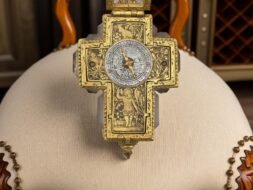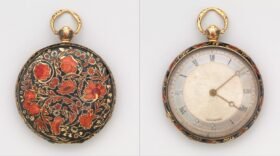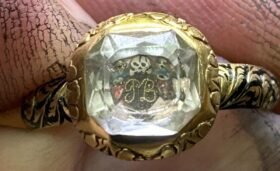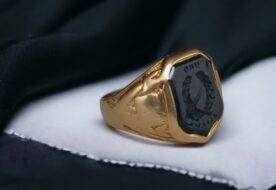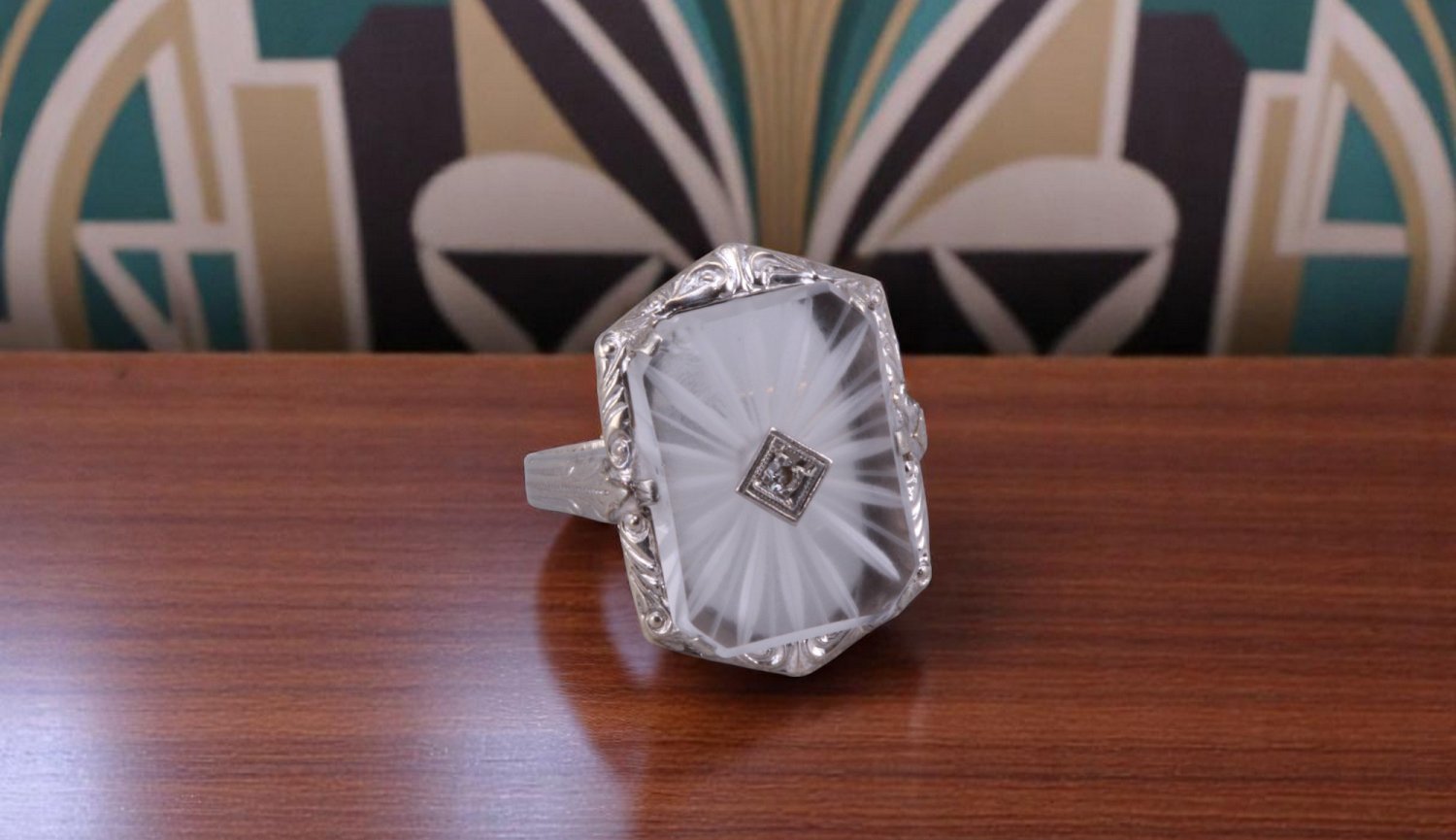
22 Apr Antique Rock Crystal Jewelry and Watches
Seen Above: Purchased by C. Blackburn Jewelers, An Antique Rock Crystal Ring Fashioned in White Gold from the Art Deco Period
Rock crystal, with its striking clarity and natural brilliance, has fascinated artisans, collectors, and historians for centuries. It’s also one of our favorites at C. Blackburn Jewelers in La Jolla. We are always excited when a customer brings in a rare piece of antique rock crystal jewelry for an evaluation and cash offer.
Far more than just a decorative material, this clear, colorless form of quartz has played a notable role in both jewelry design and horology, valued not only for its appearance but also for its symbolic and practical qualities. From ancient amulets to the refined timepieces of European courts, antique rock crystal items reflect a deep intersection between nature, craftsmanship, and culture.
The Origins of Rock Crystal: A Geological and Cultural Perspective
Rock crystal is a transparent, high-purity variety of quartz composed of silicon dioxide (SiO₂). It forms naturally over millions of years when silica-rich solutions cool and crystallize in the Earth’s crust. The absence of impurities gives the crystal its signature clarity. Its relatively high hardness (ranking 7 on the Mohs scale) and its ability to be polished to a fine finish made it an appealing choice for artisans throughout history.
Ancient civilizations — particularly the Egyptians, Greeks, Chinese, and Romans — were drawn to rock crystal not only for its clarity and beauty but also for its perceived metaphysical properties. Many believed it had protective powers or healing abilities. The Greeks thought rock crystal was water that had frozen so solidly it could never melt, and the Chinese associated it with purity and balance. Roman physicians sometimes used crystal spheres to cauterize wounds, taking advantage of the way rock crystal could focus sunlight.
This early reverence for rock crystal was linked to both its rarity and appearance. Natural rock crystal was not as widely available as other materials, and the difficulty of working with it added to its prestige. The fact that it could be shaped into durable, yet delicate, forms gave it a dual appeal as both a mystical object and a display of craftsmanship.
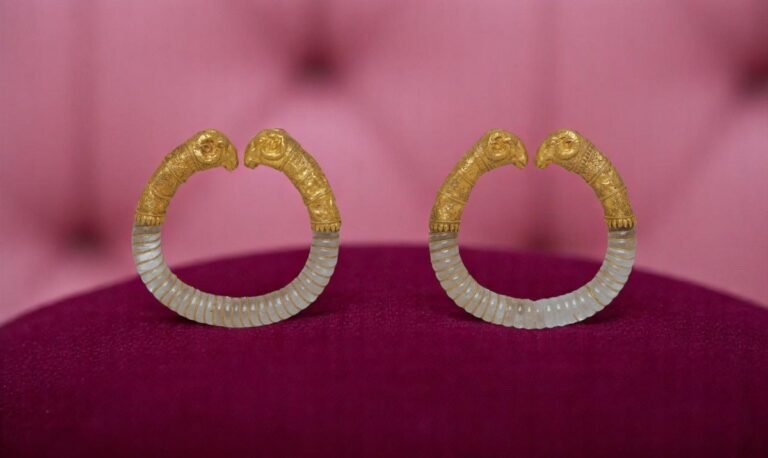
Rock Crystal in Ancient and Medieval Jewelry Traditions
The earliest examples of rock crystal jewelry date back to ancient Egypt. Egyptian artisans carved beads and amulets from the stone, often setting them in gold to enhance their visual effect. These pieces were not merely ornamental —they were believed to offer protection in the afterlife and were commonly included in burial sites.
In classical Greece and Rome, rock crystal was used to make seals, cameos, and other jewelry items. The Romans especially appreciated the aesthetic qualities of carved rock crystal vessels and decorative objects. They also incorporated rock crystal into personal adornments, such as rings and pendants, some of which have been preserved in museum collections.
During the early medieval period, the spiritual symbolism of rock crystal gained prominence in Europe. Its clarity was viewed as a metaphor for divine light and purity, making it a favored material in religious artifacts. Rock crystal was often used in the creation of reliquaries, altar crosses, and devotional jewelry. These pieces, typically mounted in gold or silver and adorned with gems, demonstrated the convergence of faith, artistry, and wealth.
Renaissance and Baroque Eras: Rock Crystal as a Luxury Material
The Renaissance era brought a renewed interest in classical art forms and techniques. Artisans in Europe — especially in Italy, France, and Germany — began experimenting with rock crystal in new ways. Advances in cutting and polishing tools allowed for greater control over the material, making it possible to create more refined and detailed designs.
Rock crystal came into vogue among the aristocracy, both as personal adornment and as part of larger decorative pieces. Ornamental boxes, scent bottles, and goblets crafted from carved rock crystal became symbols of status and refinement. Jewelers of the period frequently combined rock crystal with gold, enamel, and colored gemstones, producing richly detailed items that highlighted the transparency of the crystal.
This era also marked the beginning of rock crystal’s use in watchmaking. Early mechanical watches featured covers made of rock crystal, allowing the wearer to see the hands and mechanism while protecting the delicate inner workings. These watches were often custom-made and given as diplomatic gifts or courtly tokens, reflecting both technical innovation and artistic excellence.
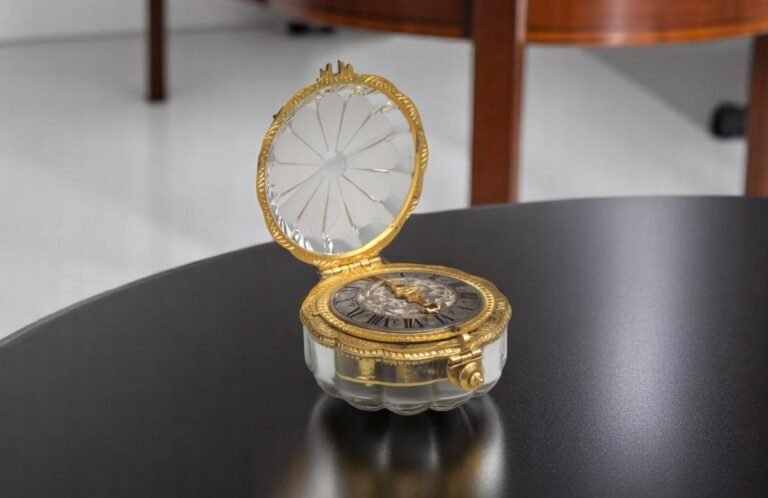
Techniques and Materials: The Craft of Antique Rock Crystal
Creating fine rock crystal pieces required both technical expertise and artistic precision. The process began with selecting high-quality, inclusion-free crystals. These were then carefully cut into the desired shape using diamond-tipped tools. Because rock crystal is relatively hard but brittle, it required a steady hand and experience to avoid fractures.
After rough shaping, the piece would be ground down using abrasives of increasing fineness. Polishing was done using mixtures of fine powder and water to bring out the crystal’s natural luster. Even a small piece could require many hours of work.
Intricate engravings and carvings were sometimes added by hand using tiny chisels or rotary tools. Floral motifs, classical figures, or religious symbols were popular design elements. The final setting — often involving gold, platinum, or silver — was carefully constructed to hold the crystal securely without overshadowing it.
Rock Crystal and the Art of Watchmaking
The introduction of rock crystal into horology brought together beauty and utility. By the 17th century, portable timepieces had become fashionable accessories, and rock crystal was increasingly used as a transparent cover that allowed the dial to remain visible while being protected from damage.
Prominent watchmakers such as Abraham-Louis Breguet in the 18th century embraced the material for its practicality and visual appeal. Breguet’s rock crystal watches often included engraving or guilloché work on the dials and cases, enhancing the luxury appeal. These watches were worn by royalty and aristocrats and are now prized by collectors for their artistry and historical value.
In the 19th and early 20th centuries, as wristwatches gained popularity, rock crystal remained in use among elite manufacturers. Brands such as Patek Philippe created one-of-a-kind pieces with rock crystal cases or embellishments, often for special commissions. The durability and optical clarity of rock crystal made it particularly suitable for such precise, decorative applications.

Designers and Houses Known for Rock Crystal Jewelry
Several major jewelry houses have embraced rock crystal in their signature styles, especially during the 19th and 20th centuries. The House of Fabergé, renowned for its intricate craftsmanship, used rock crystal in various objets d’art — particularly in flowers, desk items, and miniature sculptures. Fabergé often combined rock crystal with enamels, gold, and gemstones to striking effect.
Cartier was also instrumental in popularizing rock crystal during the Art Deco era. The clarity and geometry of rock crystal fit perfectly with the bold lines and symmetry of the movement. Cartier’s designers used the material in brooches, clocks, vanity cases, and watches — many of which were owned by royalty or Hollywood stars.
Other influential figures include René Lalique, whose jewelry and decorative pieces frequently featured rock crystal combined with glass and semi-precious stones in stylized natural forms. Suzanne Belperron, a 20th-century French designer, used rock crystal in bolder, more sculptural pieces that broke from traditional jewelry conventions. Her distinctive style remains influential today.
Collecting and Caring for Antique Rock Crystal
Antique rock crystal jewelry and watches are valued for their craftsmanship, historical context, and beauty. However, collecting these pieces requires an understanding of what makes them authentic. True rock crystal is cold to the touch, heavy for its size, and shows few internal inclusions. Imitation materials like glass or plastic often lack the same weight or temperature conductivity.
Provenance is another key factor. Documentation, maker’s marks, and appraisals can help confirm the authenticity and origin of a piece. Wear patterns, such as light surface scratches or tarnished metal settings, are common and often add to the piece’s character.
To preserve antique rock crystal items, they should be stored in soft-lined boxes away from moisture and extreme temperatures. Clean gently with a soft, dry cloth or, if necessary, with mild soap and water — never abrasive cleaners. Regular inspections by a professional jeweler can help catch any issues with settings or structural integrity before damage occurs.
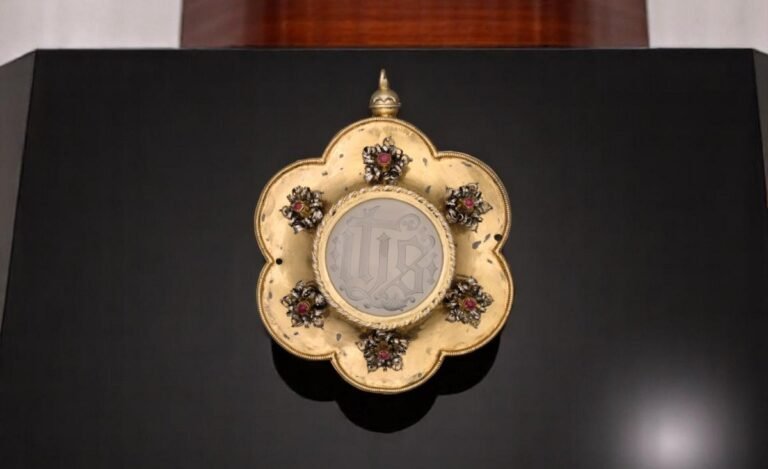
Sell Antique Rock Crystal Jewelry in San Diego
Sell your antique rock crystal jewelry today. C. Blackburn Jewelers is not only one of the most recognized buyers of signed estate jewelry in San Diego county, we are one of the highest paying buyers of rock crystal jewelry in the country, especially when it comes to rock crystal rings, earrings, and pendants made by Cartier, Tiffany & Co., and other fine jewelry makers.
Tell us a little bit about the antique rock crystal jewelry you would like to sell by leaving a voice message at 858-251-3006 or sending us a text message at 619-723-8589. You may also send an email by using the contact form below.

